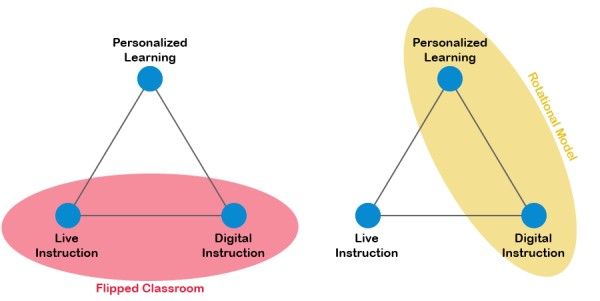Blended learning is putting students in the driver’s seat of their own education. By leveraging the power of technology, teachers are finding new ways to differentiate instruction and pacing, moving students from passive recipients to active participants in their education.
The promise of blended learning models is that they have the potential to integrate online instruction with face-to-face learning in ways that enable personalized learning for each student.
But fully delivering on this promise is a tall order. Two of the more popular blended learning models each have their own key shortcomings that prevent them from enabling the deeply student-centered learning that blended models have the potential to deliver.
The Flipped Classroom: The Personalization Challenge
In the Flipped Classroom model, students watch video lessons at home and then use in-class time on projects and deeper discussions. A teacher might assign her class a Khan Academy video on measuring probability as “homework”, then have students play a Deal or No Deal-style game followed by discussion during class.
This approach allows teachers to dedicate classroom time to activities that call for student interaction and collaboration with other students, while using at-home time for more individual activities. Because the teacher is responsible for selecting the content for class, there’s generally strong alignment between what students learn at home online and what they learn in the classroom.
However, teachers typically assign digital content to students based on the skills that the whole class is learning at that time. If a student hasn’t mastered the prerequisite skills to learn that lesson on probability, they aren’t likely to understand it no matter how it’s delivered. Conversely, students who have already mastered probability must still take the time to relearn the skill with the rest of the class even though their time would be better spent learning something new. While the flipped classroom might allow for more engaging and efficient use of time, instructional content is not necessarily personalized to a student’s unique needs and abilities.

The Rotational Model: The Syncing Challenge
In the Rotational Model, students typically rotate among two or three different learning stations, at least one of which is online. When working online, students are typically using an off-the-shelf adaptive learning product that remembers where they last left off and provides them with content based on their individual skill level.
The challenge here is that when these students rotate to teacher-led instruction, they will likely learn something different than what they learn with adaptive software. It’s nearly impossible for teachers to identify what each student has worked on that day while online and immediately plan a live instructional lesson to reinforce that specific lesson. Ask any student in a rotational model what they are working on online, then ask them what they are working on with their teacher, and you’ll likely hear two different answers.
Learning two different math skills in the same day is not necessarily a bad thing, especially for students who have gaps on pre-grade skills and still need to master grade-level content. But the real power of blended learning is when different instructional approaches are used to reinforce and deepen conceptual understanding. When content is not in sync, that opportunity is lost.
The Future of Blended Learning Requires Re-imagining the Classroom
Ultimately, the most effective blended models will be those that focus on the synchronization of live and digital instruction in ways that are personalized to the needs of each student. The first generation of blended learning models represents a meaningful leap forward from the traditional classroom model, providing students a more engaging learning environment and giving teachers the tools they need to do what they do best.
But these models make limited use of what’s truly possible. These shortcomings are not a reflection of the technology or a lack of desire to accelerate student learning, but rather are the result of attempting to graft technology solutions on top of a traditional classroom model that was never designed with technology in mind.
That’s why fulfilling the promise of blended learning requires re-imagining the classroom itself in ways that are mindful of what teachers do best, the realities of students’ learning differences, the processes that drive how classrooms are organized, and the capabilities of 21st century technologies. It requires the thoughtful design from a team of academic, technical, and operational experts who can collectively and coherently bring to life a new way of doing school.
That’s the path that New Classrooms is on. Our first classroom model, Teach to One: Math, is currently operating in 15 pioneering schools.
Over the last three years, we’ve developed a set of algorithms that choreographs the movement of students between learning stations (that include both live and digital instruction), the skills and concepts each student is ready to learn, and, most important for personalization, which of their classmates need the same skill at that time. As a result, students spend more time on skills they are ready to learn, understand their personal learning goals, and are accountable for their own learning. Learn about our first-year results in this PDF.
Like in other blended approaches, participating students learn from teachers and with technology at home and in school. But unlike the flipped classroom, the skills that each student is assigned are based on what he or she has mastered the previous day, not the standard, grade-level scope and sequence. And unlike the rotational model, students receive a unique schedule based on real-time assessment data that allows them to learn the same skill from both live and digital sources in the same day.
Todays’ blended models and the tools that accompany them are a meaningful advancement from the factory-model classroom. But absent a more fundamental redesign of the classroom itself, their impact will be limited. Fulfilling the true promise and potential of blended learning will require dozens more organizations that are holistically reimagining the classroom in ways that are less constrained by the current structure of schooling.


